Bali is often called the “Island of a Thousand Temples,” but in reality, the island is home to more than 20,000 sacred shrines. From cliffside sanctuaries to hidden jungle caves and water temples fed by natural springs, each one tells a story of faith, myth, and artistry woven into the fabric of Balinese life.
Exploring these temples is not just about admiring architecture. It’s about experiencing living traditions, witnessing ceremonies that have been practiced for centuries, and feeling the harmony between nature and the divine. Every visit invites you to see Bali through a deeper lens, where myth and reality meet in the most enchanting way.
To guide your journey, we’ve handpicked 7 of the most unique temples in Bali. These are the places that go beyond the ordinary, each promising an experience you’ll carry long after you’ve left the island.
Own your COCO property in paradise with benefits for life
- +200 properties in construction
- +250 properties in full operation
- Pay 20% of your property straight from rental profit
What Are Balinese Temples Called?
In Bali, temples are called “Pura”, a term derived from Sanskrit meaning “walled city” or “palace.” These temples play a crucial role in the Tri Hita Karana philosophy, which emphasizes the harmony between humans, nature, and the divine.
Bali has so many temples because of its strong Hindu influence—each village typically has at least three temples:
- Pura Puseh (temple of origin)
- Pura Desa (village temple)
- Pura Dalem (temple of the dead)
Additionally, temples dedicated to nature, water sources, and mountains are scattered across the island, making Bali a truly spiritual destination.
Unique Bali Temples You Must Visit
1. Besakih Temple (Mother Temple of Bali)
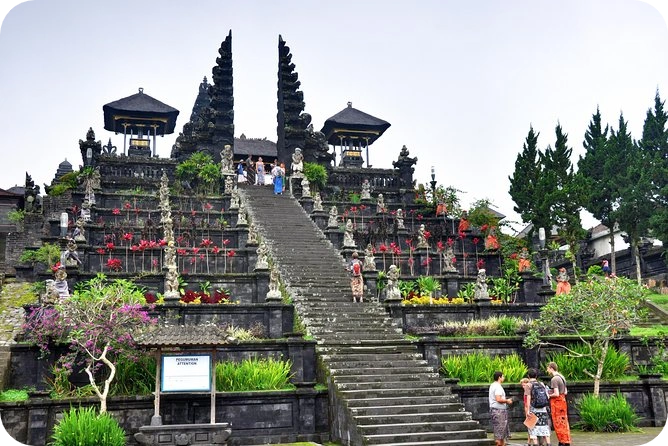
When you’ve decided to go temple hopping during your Bali trip, start strong with Besakih Temple—the largest and most sacred temple complex on the island. Nestled 900 meters above sea level on the slopes of Mount Agung, this grand complex, often called the Mother Temple, consists of over 80 temples, each with intricate pagoda-like shrines, breathtaking mountain views, and daily religious ceremonies.
The name Besakih originates from the Sanskrit word “Wasuki”, meaning salvation, and is also linked to Naga Besukian, a mythical dragon-god believed to reside in Mount Agung. Its history dates back to 1007 AD, making it one of Bali’s oldest temples, and by the 15th century, it had become the spiritual center of Balinese Hinduism. The temple embodies the Balinese philosophy of Tri Hita Karana, which emphasizes harmony between humans, nature, and the divine—a belief deeply reflected in its tranquil setting and rituals.
For a truly spectacular experience, visit during the Odalan festival, which occurs every 210 days in the Balinese calendar. During this time, the temple is transformed into a sea of colors, adorned with golden fabrics, towering Penjor (decorated bamboo poles), umbrellas, and intricate offerings. The atmosphere is lively yet deeply spiritual, filled with traditional processions, gamelan music, and sacred ceremonies.
- Location: Jl. Raya Besakih, Rendang, Karangasem Regency, Bali 80863
- Entrance Fee: IDR 60,000 ($3.65) for locals; IDR 150,000 ($9) for tourists
- Opening Hours: 8:00 AM – 6:00 PM
- Amenities: Parking space, small shops, a shuttle service and restrooms.
- Accommodation: Several hotels nearby, including Tapa Agung View, Camaya Bali, and Besakih Homestay & Villa.
- What to Expect: Expect an incredible panoramic view of Mount Agung. While you’re at it, you can walk around over 80 temples in the Besakih complex and soak in every intricate multi-tiered shrine (meru) and the religious ceremonies held daily within the complex.
2. Pura Lempuyang (Gates of Heaven)
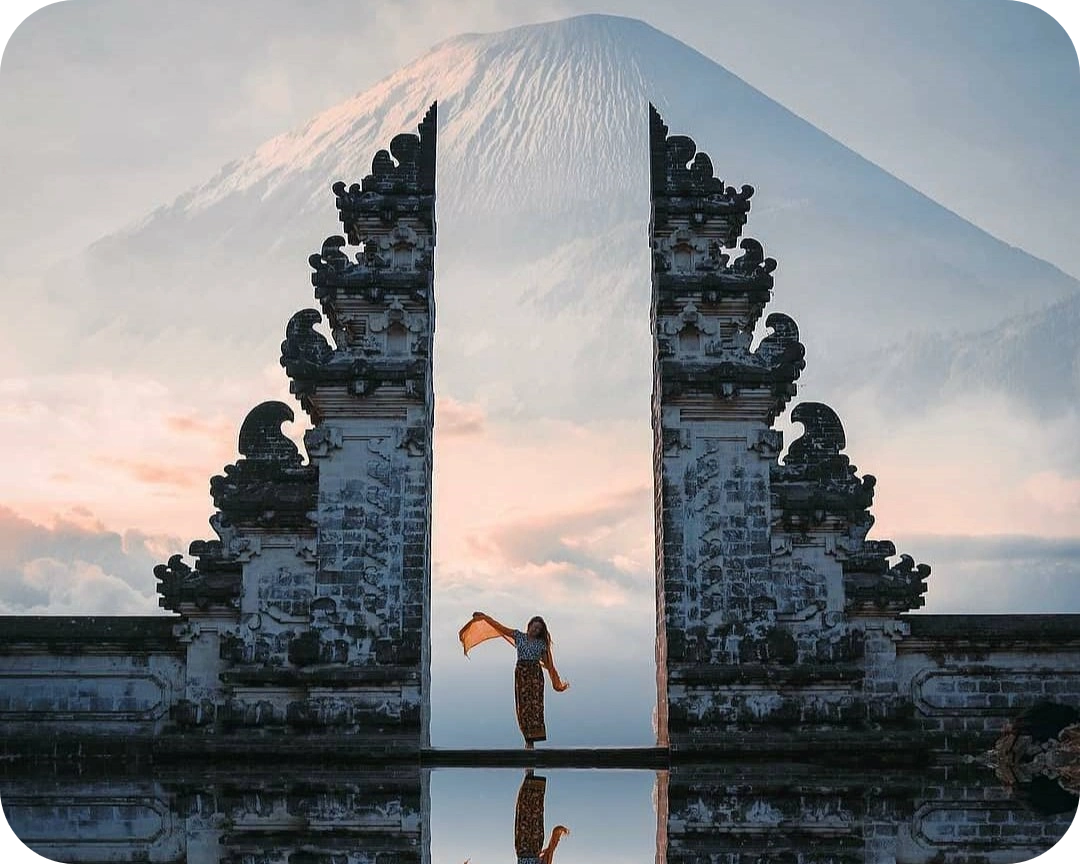
If you’ve already planned a visit to Besakih Temple, you might as well head over to Lempuyang Temple for the perfect cultural immersion into East Bali’s sacred temples. Known as Pura Lempuyang, this 11th-century temple is not just a visual masterpiece but also one of the six holiest worship sites in Bali. It’s most famous for its “Gates of Heaven”, a stunning 4-meter-high split gate that perfectly frames Mount Agung, creating an ethereal backdrop that has made it a social media sensation.
While the view is breathtaking, be prepared for long queues if you want the iconic mirrored photo. The temple itself is part of a larger seven-temple complex, with the main shrine requiring a challenging 1,700-step climb—a journey that many take as a spiritual pilgrimage. If you prefer a quieter and more peaceful experience, consider booking the Lempuyang Sunrise Tour, which offers a chilly morning atmosphere and fewer crowds.
For those visiting as part of an East Bali Day Tour, Lempuyang is often included in the itinerary alongside Tirta Gangga Water Palace and Taman Ujung. However, while admiring the temple’s beauty, respecting the natural surroundings is crucial—disturbing the flora and fauna is strictly prohibited and can result in fines.
- Location: Jl. Pura Telaga Mas Lempuyang, Tri Buana, Kec. Abang, Kabupaten Karangasem, Bali 80852
- Entrance Fee: IDR 150,000 ($9)
- Opening Hours: 7:00 AM – 5:00 PM
- Amenities: Food and drinks stalls, restrooms, parking, and a shuttle service.
- Accommodation: Several hotels and resorts nearby, including Palm Terrace, Lumbung Seraya Villa, and Kelapa Cottage.
- What to Expect: Many spots for Instagram-worthy pictures capturing the breathtaking views of Mount Agung right in the middle of the temple gate. However, expect long queues for photos, though you can experience a cooler mountain climate, and a peaceful yet sacred atmosphere, especially during temple ceremonies.
Invest in Bali’s #1 Lifestyle Property Brand
Discover high-yield villa investments starting at just $50,000 with average returns of 17–20%—all in one of the world’s most sought-after destinations.
3. Tirta Empul Temple (Holy Water Spring Temple)
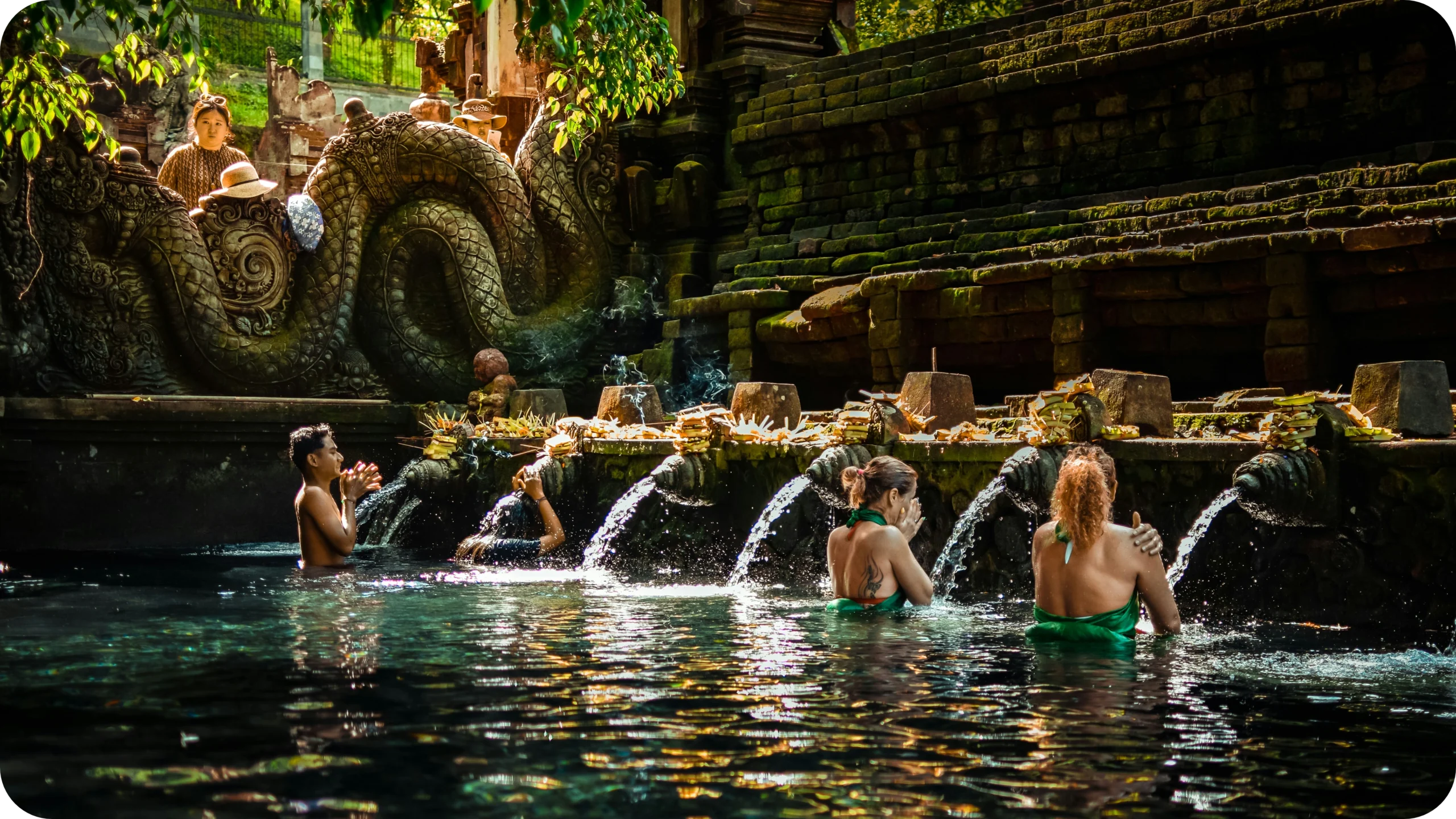
If you’re looking for a spiritually immersive experience in Bali, Tirta Empul Temple is a must-visit. Translating to “holy water spring”, this 10th-century temple is one of the holiest sites on the island, built around a natural spring believed to have been created by the Hindu god Indra to purify his troops. Today, both locals and visitors come here to take part in the Melukat cleansing ritual, a traditional purification where worshippers move through a series of fountains to wash away negativity and seek blessings.
The temple complex, recognized as a national cultural heritage site, features a large petirtaan (bathing structure) where crystal-clear spring water flows into Tukad Pakerisan River. Balinese Hindus consider this water to be sacred, using it for rituals dedicated to Vishnu, the Preserver of Life in Hinduism. If you want to join the purification ritual, you’ll need to wear a special green sarong, which is available for rent at the temple, and make a small offering to the gods before entering the water.
- Location: Jalan Tirta, Manukaya village, Tampaksiring District, Ubud, Gianyar Regency, Bali 80552
- Entrance Fee: IDR 50,000 ($3.25) or IDR 25,000 ($1.50)
- Opening Hours: 8:00 AM – 6:00 PM
- Amenities: Parking space, lockers, and changing rooms.
- Accommodation: Several hotels and resorts nearby, including Bambootel Sawah, Kayon Jungle Resort and Alam Sari Resort.
- What to Expect: Expect tourist crowds especially during late mornings and the afternoon.
Note: Visitors should dress modestly when entering the temple, but sarongs are available for rent at the entrance. It’s also highly recommended to hire a local guide, as they can walk you through the proper rituals and temple etiquette, ensuring you don’t unintentionally show disrespect.
4. Tanah Lot Temple (Sacred Temple by the Sea)

If you’re chasing unforgettable sunset views in Bali, Tanah Lot Temple is the place to be. Perched on a rugged rock formation in the ocean, this iconic temple seems to float on water when the tide is high, creating one of the most picture-perfect sights on the island. But beyond its Instagram-worthy appeal, Tanah Lot holds deep spiritual significance—it was founded in the 16th century by the revered Hindu priest Dang Hyang Nirartha and is dedicated to the sea gods, symbolizing the connection between nature and the divine.
During high tide, waves crash dramatically against the temple’s base, making the temple completely inaccessible, while at low tide, a natural stone pathway appears, allowing visitors to get a closer look—though the inner sanctum remains reserved for worshippers. And the real highlight? As the sun dips below the horizon, Tanah Lot becomes a stunning silhouette against a fiery sky, making it one of the most unforgettable sunset spots in Bali.
- Location: Jalan Tanah Lot, Beraban, Kediri, Tabanan Regency, Bali 82121
- Entrance Fee: IDR 75,000 ($4.50)
- Opening Hours: 7:00 AM – 7:00 PM
- Amenities: Parking space, several shops, restrooms, and a dining spot.
- Accommodation: Several hotels and resorts nearby, including Natya Hotel Tanah Lot and De Moksha Boutique Resort
- What to Expect: Be prepared for tourist crowds, especially around sunset, when the temple is at its most magical. While exploring, take a short walk to Batu Bolong Temple, a nearby clifftop shrine offering equally stunning ocean views. And if you’re feeling drawn to the spiritual side of Tanah Lot, you can even participate in a traditional blessing ceremony for a more immersive experience.
5. Uluwatu Temple (Pura Luhur Uluwatu): The Cliffside Temple
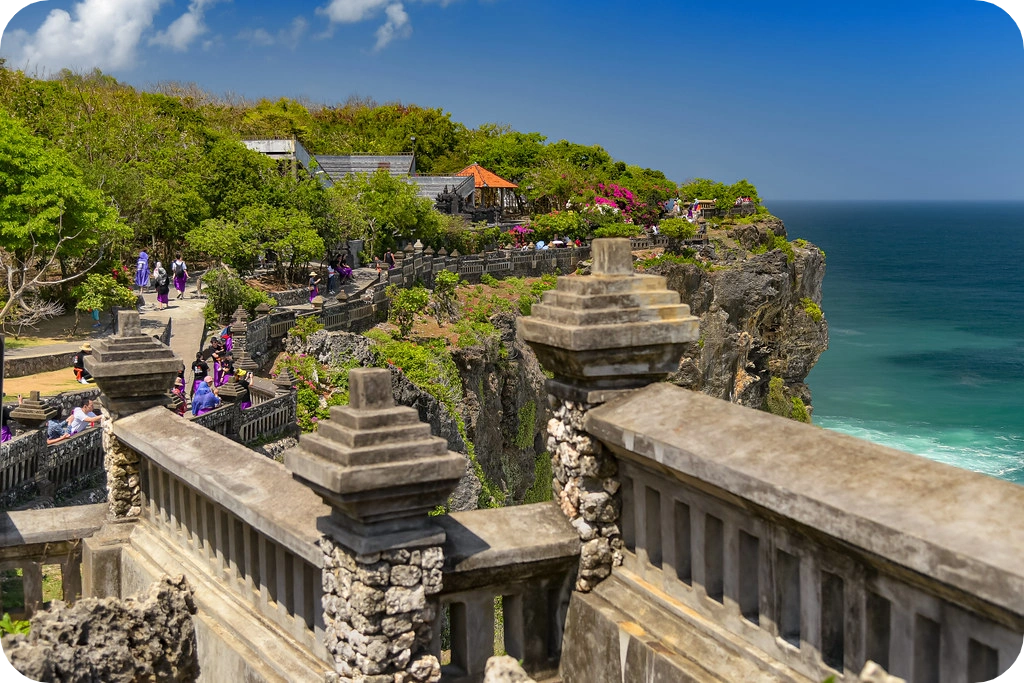
Uluwatu Temple, or Pura Luhur Uluwatu, is Bali’s most famous temple and should be at the top of your Uluwatu guide list. Perched on the edge of a dramatic 70-meter-high cliff, this 10th-century Hindu temple offers awe-inspiring views of the Indian Ocean. Part of the Sad Kahyangan Jagat—the six most sacred temples in Bali—Uluwatu Temple is said to be dedicated to the spirits of the sea and holds deep religious significance in Balinese Hinduism. It is believed to be a confluence for the powers of Brahma, Vishnu, and Shiva, making it a focal point for worshiping Siva Rudra, the deity of all life forces in the cosmos. Historically, it is believed that the temple’s roots trace back to Megalithic times, evidenced by an ancient coffin divided into two stone troughs (sarcophagus).
Aside from that, the temple also houses hundreds of long-tailed macaque monkeys believed to be the ones guarding the temple from evil influences, but in reality, these friends are far from being behaved. They can be as cheeky as they wanted and sometimes, have the mischievous habit of snatching personal items!
- Entrance Fee: Around IDR 30,000 ($2.5 USD).
- Opening Hours: 8:00 AM – 7:00 PM
- Amenities: Small shops, a café, and restrooms.
- Accommodation: Several hotels nearby, including luxurious cliffside resorts like Anantara Uluwatu Resort.
- What to Expect: Expect an incredible view of the ocean. While you’re at it, watch the famous Kecak Fire Dance performance which stages episodes from the Ramayana at sunset which takes place at the temple’s open-air amphitheater, though there is a charge of IDR 100,000 per person. It is also advisable to take a look at the resident monkeys that roam the temple grounds, although they can be quite cheeky at times.
why investors choose
coco development group?

Passive income on full auto pilot
Profit Maximization
We do not just put your property on Airbnb hoping for a guest to book it. More than 40% of our bookings comes today through our own medias, a strong community and a digital and data driven management approach.
A Convenient and fast payment system
The investors receive net profits currency that is convenient for them. we transfer the money once every three months
No need to handle taxes
High Liquidity
Fast Payback
Oceanside villas in Bali are in High demand for daily rentals. You will earn about 5000 USD per month
6. Pura Taman Saraswati (Ubud Water Palace)
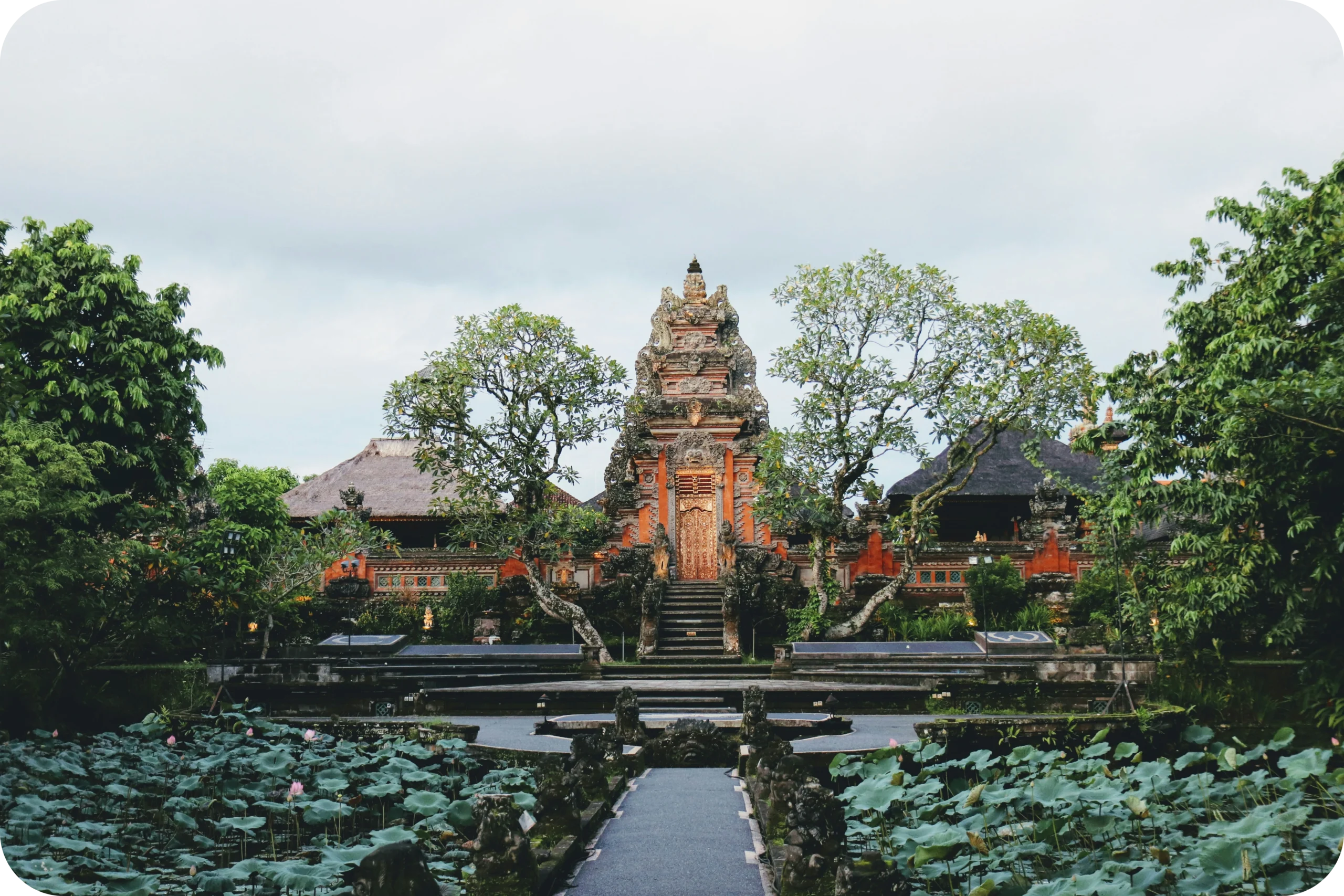
If you want to experience a perfect blend of spirituality, art, and nature in the centermost region of Ubud, Pura Taman Saraswati is your place to be. This majestic temple is known to be dedicated to Saraswati, a Hindu goddess of knowledge, wisdom, and the arts, and you’ll see her influence in the temple’s every detail!
The goddess is also believed to be associated with the lotus pond, making it the true highlight of the temple, offering a picturesque setting for reflection or photos. Aside from that, the temple also features the Aling-Aling, a unique Balinese wall believed to have been designed to confuse evil spirits, and the magnificent Padmasana Shrine, featuring volcanic tuff carvings of cosmic turtles and nagas, symbols of Hindu mythology.
- Location: Jl. Suweta No.6, Ubud, Kecamatan Ubud, Kabupaten Gianyar, Bali 80571
- Entrance fee: Entry is free but Balinese dance performances at the Cafe Lotus (by the lotus pond) costs around IDR 50,000 (or about $3.25)
- Opening hours: 7:00 AM – 5:00 PM
- Accommodation: Several hotels and resorts nearby, including SenS Hotel & Spa and Pura Saraswati Dijiwa Ubud.
Pro Tip: Saraswati is just a short walk from the Ubud Art Market and the Royal Palace (Puri Saren Agung) so you might want to squeeze in a quick visit to the temple while you’re in the area.
7. Goa Gajah (Elephant Cave)
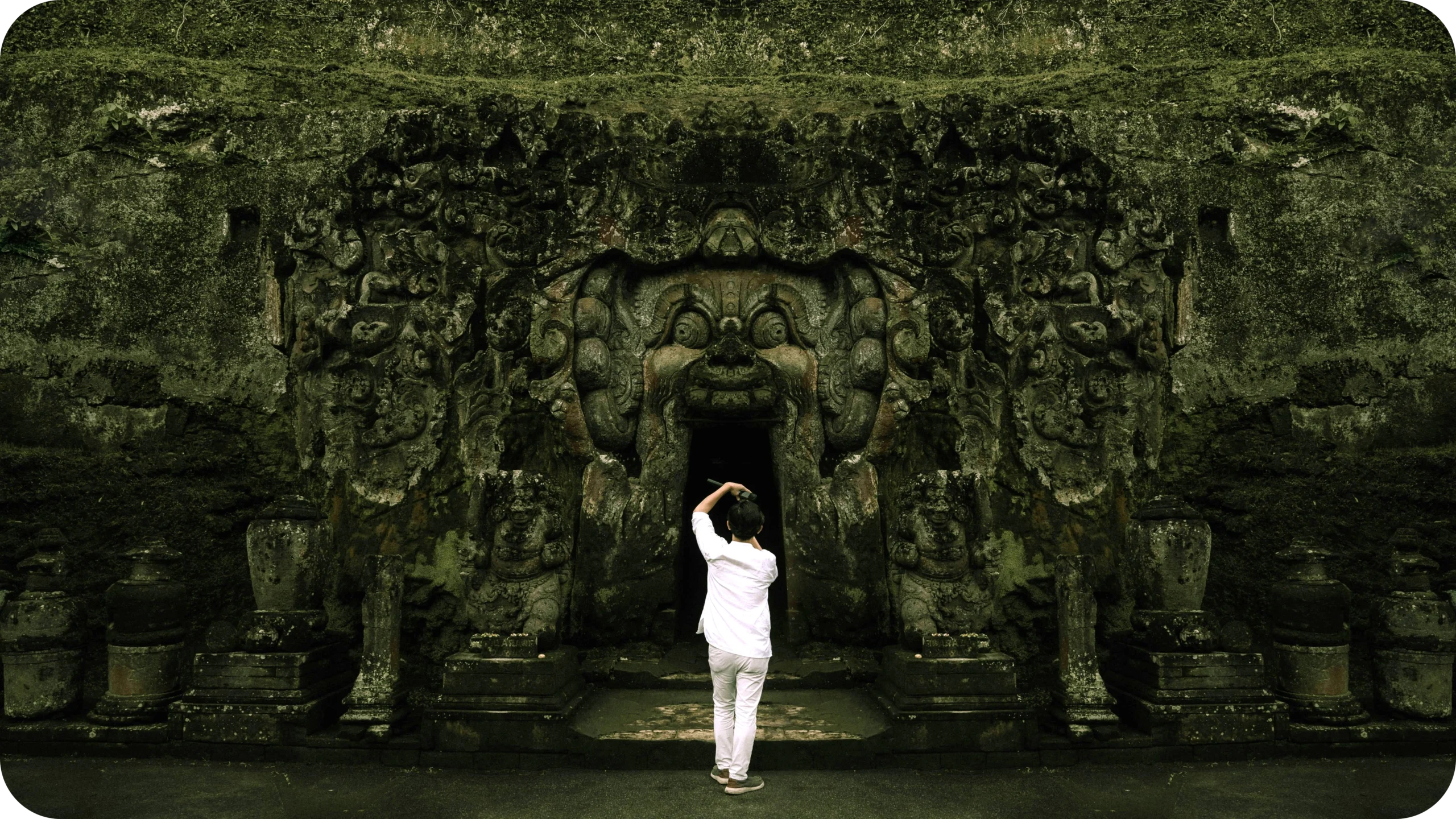
A fascinating Ubud historical site, Goa Gajah is an ancient temple complex dating back to the 9th century. This meditative sanctuary is known for its intricately carved stone facades with detailed carvings of animals and deities. Its name, “Elephant Cave,” is derived from nearby elephant-shaped carvings and a large Ganesh statue inside. Plus, the site also includes a tranquil bathing pool, adding to its serene and spiritual atmosphere.
- Location: Jl. Raya Goa Gajah, Bedulu, Blahbatuh, Gianyar, Bali 80581
- Entrance fee: IDR 50,000 (or about $3.25)
- Opening hours: 8:00 AM – 6:00 PM
- Accommodation: Mancur Guesthouse, Bojig House Ubud, and Ubud Dedari Villas.
Tip: Be cautious while exploring, especially if visiting during the rainy season, as the steps and rocks can be slippery.
Unique Temple Features and Experiences
In conclusion, Bali’s temples are more than just stunning architectural landmarks—they offer one-of-a-kind experiences that make each visit special. Whether it’s a ritualistic purification, a spiritual trek, or a breathtaking sunset view, here are some must-try experiences when visiting Bali’s temples.
1. Temples with Natural Elements – Water, Mountains, and Caves
Some temples in Bali are deeply intertwined with nature, making them not just places of worship but also sites of environmental harmony.
- Water Temples: These temples, such as Pura Ulun Danu Beratan, are located near lakes or rivers and are dedicated to Dewi Danu, the goddess of water and agriculture. They play a key role in Bali’s Subak irrigation system, which is recognized as a UNESCO Heritage practice.
- Mountain Temples: Situated at high altitudes, Pura Luhur Batukaru and Lempuyang Temple offer a tranquil escape from the crowds, with misty landscapes and cool air enhancing the spiritual atmosphere.
- Cave Temples: Goa Gajah (Elephant Cave) and Goa Lawah (Bat Cave Temple) are carved directly into rock formations, adding a sense of mystery and ancient energy to these sacred sites.
2. Rituals and Blessings You Can Participate In
Many temples in Bali allow visitors to take part in spiritual ceremonies, offering a deeper cultural connection beyond sightseeing.
- Purification Rituals (Melukat): At water temples like Tirta Empul, visitors can participate in a cleansing ceremony, where holy spring water is poured over them to remove negative energy.
- Traditional Offerings (Canang Sari): You may notice locals placing small woven baskets filled with flowers and incense at temple shrines. Some temples, like Taman Saraswati, allow visitors to learn how to make these offerings as a way to respect Balinese traditions.
- Priest Blessings: In some temples, such as Besakih and Uluwatu, visitors can receive a Tirta (holy water) blessing from a Balinese priest, which is believed to bring protection and good fortune.
3. Temples with Cultural Performances
While most temples are places of quiet worship, a few come alive with traditional Balinese performances, offering a glimpse into the island’s rich artistic heritage.
- Kecak Fire Dance at Uluwatu Temple: Held at sunset, this dramatic, chant-based dance tells the story of the Ramayana while performers sit in a circle and move rhythmically to hypnotic chants.
- Legong Dance at Taman Saraswati: Set against the temple’s lotus pond backdrop, this elegant dance features intricate movements performed by young Balinese dancers.
- Wayang Kulit (Shadow Puppetry) at Pura Dalem Ubud: Some temples host traditional shadow puppet performances, telling mythological and historical stories through delicate leather puppets and a gamelan orchestra.
4. Best Temples for Stunning Sunrises and Sunsets
If you want breathtaking views, timing your visit around sunrise or sunset can make all the difference.
- Best sunrise temples:
- Lempuyang Temple – “Gates of Heaven” with a stunning view of Mount Agung emerging through morning mist.
- Ulun Danu Beratan – Misty reflections on the lake as the sun rises.
- Best sunset temples:
- Tanah Lot – The ocean surrounds this offshore temple, creating a golden-hour silhouette.
- Uluwatu Temple – Perched on a dramatic cliff, offering panoramic sunset views over the Indian Ocean.
Future-Proof Your Investment With High Liquidity
Our prime Bali locations drive property value growth by up to 35% upon completion, ensuring both strong appreciation and an easy sell if you choose to exit.
Temple Festivals and Ceremonies You Must Experience
Bali’s temples come to life during vibrant Hindu festivals, where you’ll witness locals in traditional attire, elaborate offerings, and beautiful rituals. If you’re lucky, you might even get invited to join!
1. Odalan (Temple Anniversary Celebrations)
Every temple in Bali has an anniversary (Odalan) celebrated every 210 days according to the Balinese calendar. These events feature:
- Colorful offerings of fruit, flowers, and incense
- Traditional dance performances
- Community prayers and processions
Tip: If you visit a temple during its Odalan, expect a festive, yet spiritual atmosphere—it’s an amazing way to experience authentic Balinese culture!
2. Galungan and Kuningan – When the Gods Visit Bali
- Galungan marks the return of ancestral spirits to visit their family homes. You’ll see penjors (bamboo poles decorated with offerings) lining the streets.
- Kuningan, celebrated 10 days after Galungan, is when the spirits return to heaven.
Tip: Visit a Balinese village during Galungan to witness locals in their finest traditional attire heading to temple ceremonies.
3. Nyepi (Balinese Day of Silence)
Nyepi is Bali’s New Year, unlike any other holiday in the world. It’s a day of complete silence, where even flights are grounded, and no one is allowed outside.
- The night before Nyepi, Ogoh-Ogoh parades take place—huge demon-like statues are carried through the streets, then burned to ward off evil spirits.
- On Nyepi itself, no lights, no noise, and no travel are allowed.
Tip: If you’re in Bali during Nyepi, stock up on food and enjoy the rare chance to experience absolute peace—the night sky is spectacular!
4. Melasti Ceremony – A Purification at the Beach
This pre-Nyepi ritual sees thousands of Balinese march to the sea, carrying sacred temple objects for cleansing. It’s a beautiful and spiritual sight.
Tip: Head to Sanur or Kuta Beach before Nyepi to watch the Melasti processions—the combination of Balinese attire, colorful umbrellas, and sacred relics is breathtaking.
Things to Know Before Visiting Balinese Temples
1. Temple Etiquette
Balinese temples are sacred places, so proper behavior and attire are expected. Follow these etiquette rules to show respect:
- Wear a sarong and sash – These are required and can usually be rented at the entrance.
- Dress modestly – Shoulders and knees should be covered; avoid revealing clothing.
- Remove shoes before entering temple grounds.
- Do not climb on shrines or temple structures – These are holy spaces, not tourist attractions.
- Avoid public displays of affection – Holding hands, hugging, and kissing are seen as disrespectful.
- Follow temple rules during ceremonies – If a prayer is in progress, stand back and observe quietly.
2. What to Prepare Before Visiting
A little preparation goes a long way in ensuring a smooth temple visit:
- Bring your own sarong or rent one at the entrance to avoid extra hassle.
- Carry small cash for entrance fees, donations, and offerings, as many temples don’t accept cards.
- Wear comfortable shoes – Some temples, like Lempuyang and Besakih, require a lot of walking or climbing.
- Bring water and sunscreen – Many temples are outdoors with little shade, and the Balinese sun can be intense.
- Visit early in the morning to enjoy a quieter, more peaceful experience with fewer crowds.
3. Tours & Transportation
Some temples are far from main tourist areas, so planning your transport is essential:
- Hire a driver or book a guided tour for remote temples like Besakih and Lempuyang, as public transport is limited.
- Consider a combo tour if you plan to visit multiple temples in one day (e.g., Uluwatu, Tanah Lot, and Ubud temples).
- Plan for traffic – Some temple routes, especially to Tanah Lot and Uluwatu, can get congested, particularly in the late afternoon.
4. Other Important Rules for Tourists
Balinese temples have strict cultural and spiritual guidelines, so keep these in mind:
- Women on their period are not allowed to enter temples due to religious beliefs.
- Drones are prohibited unless you have prior permission from temple authorities.
- Do not step over offerings (small woven baskets with flowers and incense) placed on the ground—walk around them instead.
- Respect prayer times – Avoid walking in front of worshippers, interrupting ceremonies, or taking intrusive photos.
- Avoid touching sacred objects or statues—these hold deep spiritual significance for locals.
- Keep noise levels low – Temples are places of worship, so embrace the peaceful atmosphere and be mindful of your surroundings.
Construction you can trust
We handle all the details – no hassle for you.

5 Years full warranty

20+ Finished developments in Bali by our team

25+ Years of shared experience
FAQ
While full traditional attire isn’t required, visitors are expected to wear a sarong and sash to show respect. Many temples provide them at the entrance for free or for a small donation.
Not always. Some inner sanctums are reserved exclusively for worshippers and priests. Visitors are welcome in designated areas but should respect signs and boundaries within the temple grounds.
Yes, children are welcome at most temples, but it’s important to supervise them closely. Teach them simple rules like speaking softly, not climbing on structures, and showing respect during ceremonies.
Smaller village temples and lesser-known shrines like Pura Gunung Kawi Sebatu tend to be quieter. Early mornings or weekdays are also ideal times to experience the serenity without heavy crowds.
Absolutely. Many temples have knowledgeable local guides available who can share cultural stories, rituals, and historical details you might miss on your own. It’s a great way to deepen your understanding of Balinese spirituality.
Discover the Sacred Soul of Bali
Exploring Bali’s temples is more than a journey through stone and sculpture—it’s a step into the island’s living traditions. Each temple offers its own way of connecting you to Bali’s spiritual heartbeat, whether through quiet reflection, awe-inspiring ceremonies, or moments of stillness surrounded by nature.
What makes the experience lasting is not just the sights you see, but the respect and mindfulness you bring with you. By honoring local customs and embracing the culture with openness, your temple visits become more than stops on a trip—they become part of a story you’ll carry long after you leave.
When your time in Bali comes to an end, these sacred places will stand out as more than memories. They will remain as reminders of the island’s soul, urging you to return and experience the magic once more.

Rasmus Holst is a serial entrepreneur and Co-Founder of COCO Development Group, where he helps drive innovation and growth through strategic business development. He is also the Co-Founder of Estate of Bali and Regnskabshelten.dk, Denmark’s fastest-growing accounting firm, which grew to 35 employees and generated $2.5M in turnover in 2023. Rasmus is passionate about building businesses that create long-term value and impact.














